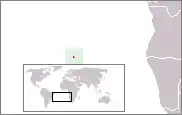Saint Helena hoopoe
The Saint Helena hoopoe (Upupa antaios), also known as the Saint Helena giant hoopoe or giant hoopoe, is an extinct species of the hoopoe (family Upupidae), known exclusively from an incomplete subfossil skeleton. It was last seen around 1550.[1]
| Saint Helena hoopoe | |
|---|---|
 | |
| Scientific classification | |
| Kingdom: | Animalia |
| Phylum: | Chordata |
| Class: | Aves |
| Order: | Bucerotiformes |
| Family: | Upupidae |
| Genus: | Upupa |
| Species: | †U. antaios |
| Binomial name | |
| †Upupa antaios (Olson, 1975) | |
 | |
| Location of Saint Helena | |
| Synonyms | |
|
Upupa antaois (lapsus) | |
It was endemic to the island of Saint Helena in the South Atlantic. It was most likely flightless.[2] The first analysis of this species was given in 1963 by the British zoologist Philip Ashmole, who discovered, in the Dry Gut sediments east of Saint Helena, a left humerus which differed significantly from that of other Upupidae.
The incomplete skeleton, which was found in 1975 by the palaeontologist Storrs L. Olson, consists of both coracoids and the left femur.[2]
References
- BirdLife International (2012). "Upupa antaios". IUCN Red List of Threatened Species. 2012. Retrieved 26 November 2013.CS1 maint: ref=harv (link)
- Storrs L. Olson. (1975). Paleornithology of St Helena Island, south Atlantic Ocean. Smithsonian Contributions to Paleobiology 23.
This article is issued from Wikipedia. The text is licensed under Creative Commons - Attribution - Sharealike. Additional terms may apply for the media files.
